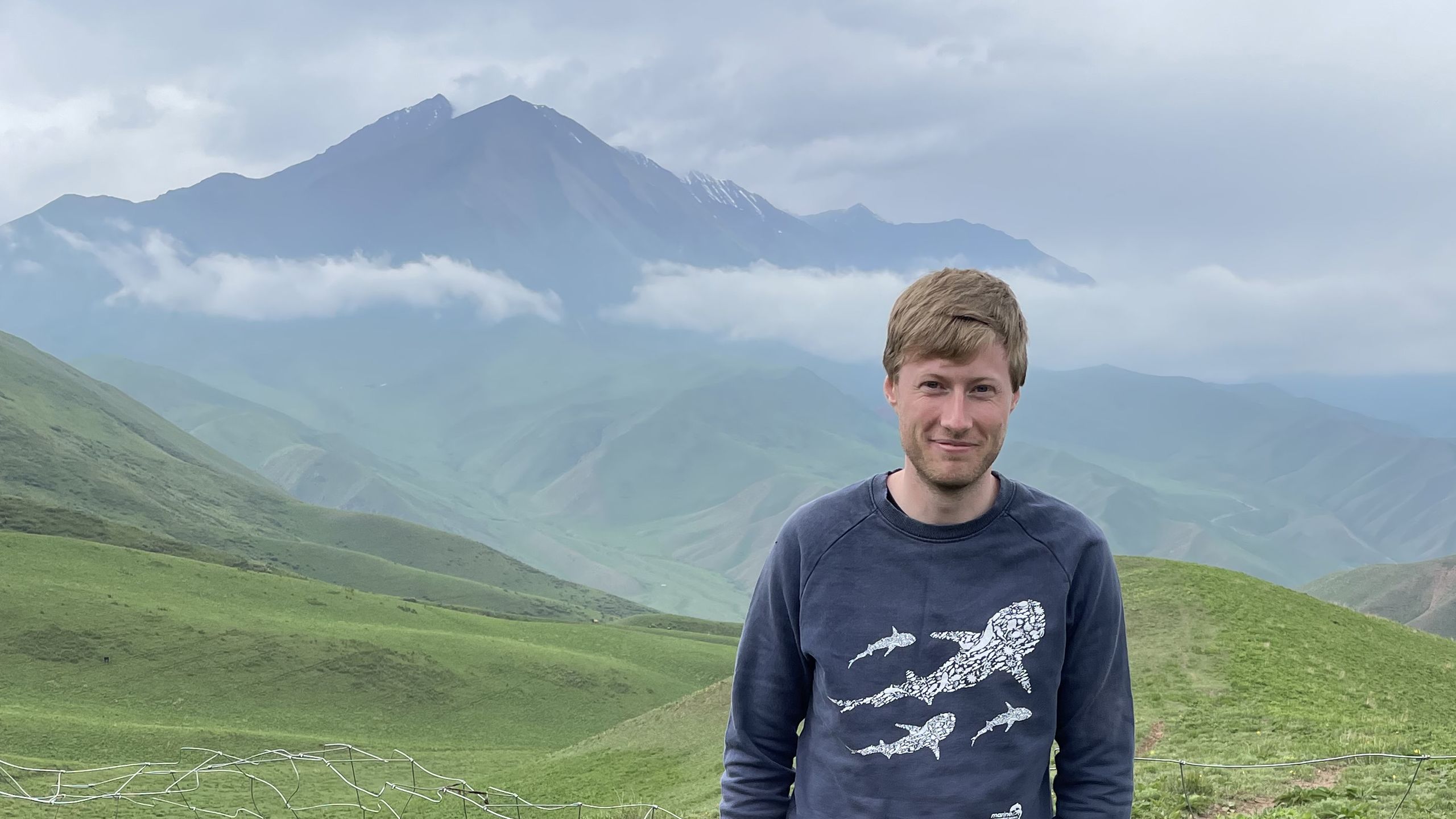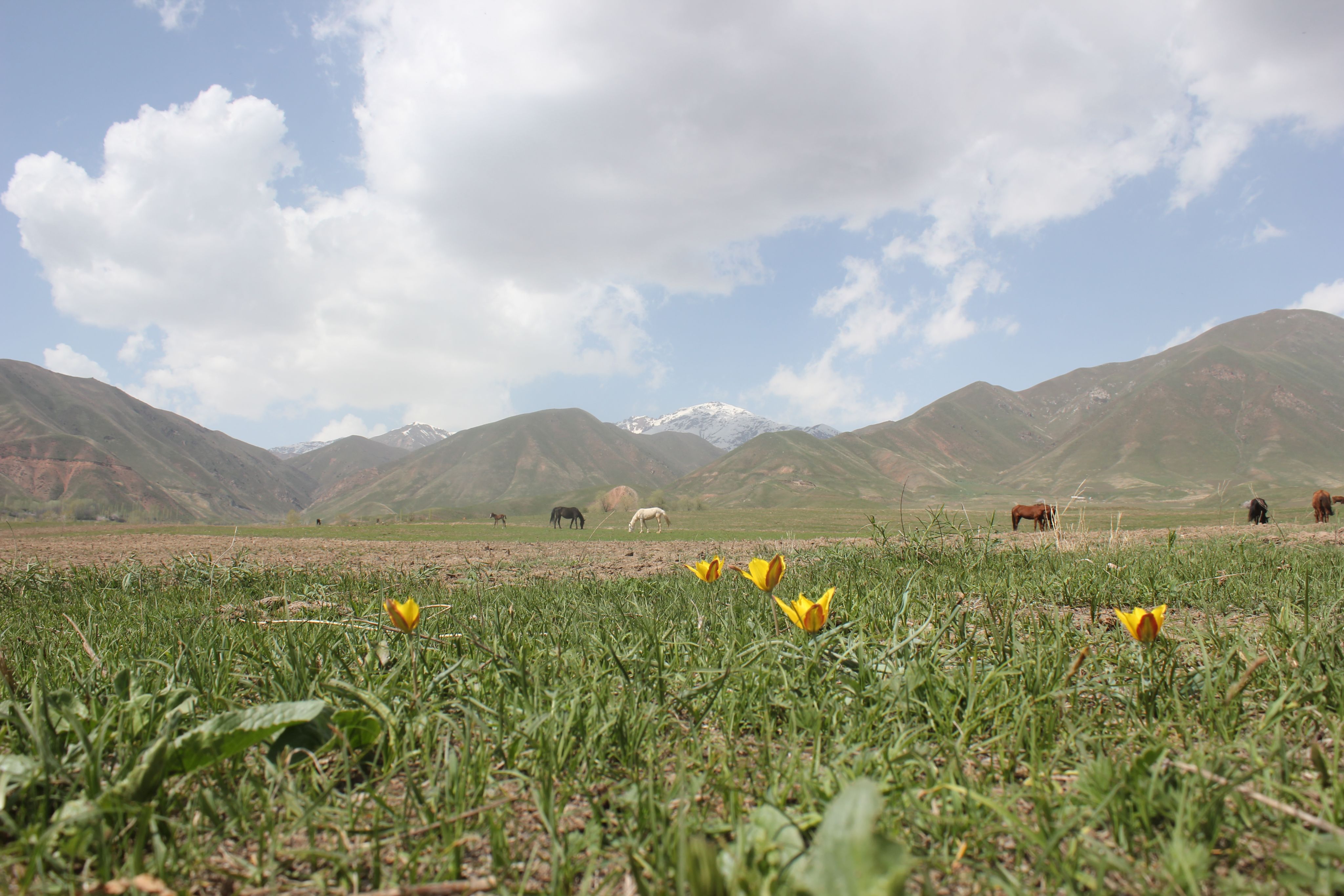This Cambridge Life
The tulip hunter
of Toktogul

Brett Wilson's love of wild tulips has taken him to some of the most spectacular places in Central Asia, where he discovered a new species in Toktogul, Kyrgyzstan. His work has helped to uncover the plight of 53 tulips which have been added to the 'Red List' of threatened species.
Wild tulips are magnificent! Some look like the garden varieties we all know so well, with tall stems topped by blousy, bucket-shaped flowers. Others are less recognisable, with delicate flowers and a slight fragrance.
There is nothing more fragile or beautiful than a flowering tulip existing in the vast expanse of nature. Wild species are tough – they can be found clinging to rocky outcrops or surviving on steep stony slopes, flowering in large mountainous meadows where grazing is common, and existing on the harsh desolate ground on the edge of deserts.
We think there are about 90–96 wild species globally, and 60 of these are in the UK's National Tulip Collections at Cambridge University Botanic Garden (CUBG) and the Royal Botanic Gardens Kew. These ex situ collections are brilliant resources to safeguard biodiversity against extinction and to showcase wild tulip diversity to the public.
My passion is conservation. I started out searching for a rare apple tree in Kyrgyzstan for my Masters. And then came the chance to return to the region to collect wild tulips for my PhD in the Department of Plant Sciences working with the CUBG’s Curator, Sam Brockington, and David Gill from Fauna & Flora International (FFI).
Kyrgyzstan is a remarkable country with a compelling history, beautiful nature, and warm and friendly people. The country is over 90% mountains with high altitude pastures full of yurts a common sight in summer and snow leopards at home on the snowy peaks. It is situated in a region that was once the heart of the Silk Road and somewhere I had never really heard about at school, primarily due to its ties to the Soviet Union and recent independence.
Tulipa anadroma growing in Sary-Chelek Biosphere Reserve, Kyrgyzstan
Tulipa anadroma growing in Sary-Chelek Biosphere Reserve, Kyrgyzstan
Tulipa ostrowskiana growing in a valley in northern Kyrgyzstan
Tulipa ostrowskiana growing in a valley in northern Kyrgyzstan
Tulipa kaufmanniana growing in the Chatkal valley of western Kyrgyzstan
Tulipa kaufmanniana growing in the Chatkal valley of western Kyrgyzstan
"Kyrgyzstan is a remarkable country with a compelling history, beautiful nature, and warm and friendly people."

Was I excited when we discovered a new species? Actually, at the time, not really! It was my first day collecting with local tulip experts Georgy Lazkov and Kaiyrkul Shalpykov of the National Academy of Sciences of the Kyrgyz Republic. It was the end of a really long day's drive, and when we saw the plant we just thought it was a bit weird. It had an elongated tunic [the outside of the bulb]. I remember us saying, 'we'll just dig one up and think about it later'.
It turned out to be something completely different. When the DNA sequence results came back, we saw it was a new group on the phylogenetic tree of tulip relationships – we'd discovered a new species of this flowering plant! We named it Tulipa toktogulica after the Toktogul area of Kyrgyzstan. We brought back seeds to add to the CUBG’s national collection and specimens to go in the herbarium. Meanwhile, Georgy and Kaiyrkul added to the Kyrgyz Republic’s national collection at Gareev Botanical Garden in Bishkek.
Naming new species isn’t always as glamorous as it may appear. New plant species are discovered all the time. But often these newly described species have a very restricted distribution and are already at risk of extinction. Understanding the diversity of plants is crucial for their protection, especially when facing new threats such as climate change.
Camping near the Toktogul reservoir after finding new species
Camping near the Toktogul reservoir after finding new species
Close up of Tulipa toktogulica
Close up of Tulipa toktogulica
"There is nothing more fragile or beautiful than a flowering tulip existing in the vast expanse of nature."

I wanted to truly represent the plight of tulip species. Over the past four years, I have been working as part of a project funded by the Department for Environment, Food and Rural Affairs (DEFRA) awarded to Sam and FFI. Supported by experts at Botanic Gardens Conservation International and the International Union for Conservation of Nature (IUCN), we have been working to improve information on wild tulip threats, to create reports for the IUCN Red List of Threatened species.
As part of this, we held a workshop in Bishkek, Kyrgyzstan, in the Spring of 2022. It was incredible! We got together with an amazing group of botanists – two each from Kazakhstan, Uzbekistan and Tajikistan, and around six from Kyrgyzstan, together with a tulip expert from the Royal Botanic Gardens, Kew. They were so interested and willing to engage and give their knowledge.
We took distribution maps and the experts would say ‘I've seen populations here and here’, and we would add distribution points and make a note. We asked where does it grow? Why does it grow there? What are the major threats? What actions should we take? We collated everything and submitted it to IUCN.
The resulting information represents several lifetimes of field experience. The individuals were happy to see that their knowledge was being used to assess the threats to wild tulips, and proud that they were able to contribute. The result: 53 tulip species have been added to the Red List, where previously none from Central Asia had been assessed.
The Red List is the so-called ‘barometer of life’, a catalyst for action to inform, raise awareness and ultimately protect biodiversity. We discovered that about 51% of all assessed Central Asian tulips are Threatened, with six Critically Endangered, the highest level of concern for wild plants. Tulips are in a worse state than many plant groups and need urgent conservation work, which will be continued by FFI, CUBG and Central Asian partners.
My PhD viva is on 9 December – the same day that the Red List is released with our work included. It'll be quite a day for me.
Brett is a Natural Environment Research Council iCASE Doctoral Training Programme student and also part of a DEFRA-funded Darwin Initiative project awarded to the CUBG’s Curator Sam Brockington and FFI. Brett is a member of St John’s College, Cambridge.
Published 9 December 2022
With thanks to:
Brett Wilson, Sam Brockington and Helen Needham
All images: credit Brett Wilson
The text in this work is licensed under a Creative Commons Attribution 4.0 International License












